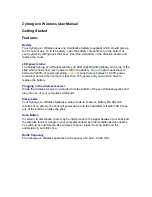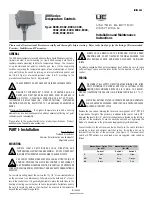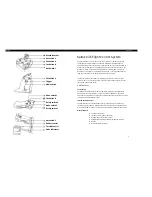
6
www.balmar.net / Customer Service: +1 (360) 435-6100 x1 / Technical Support: +1 (360) 435-6100 x3
Tech Service is available Monday - Friday (8:30am - 7:30pm EST)
neutral to ground. To utilize the Aux. #1 Lamp function:
1.
Connect a small LED or incandescent lamp (maximum current flow is 500 mA) to a
positive voltage source.
2.
Connect the negative terminal on the lamp to the Aux. #1 terminal on the regulator.
Install Dash Lamp
The Max Charge Dash Lamp (#17) terminal provides the ability to activate a visual or
audible indicator when the regulator monitors the following conditions: Low system
voltage, high system voltage, high alternator temperature, high battery temperature
(temperature conditions are only indicated when appropriate temperature sensors are
connected) and no voltage on stator, indicating that the alternator has failed. When
a described condition is detected, the regulator sends the Dash Lamp terminal from
neutral to ground. To utilize the Dash Lamp function:
1.
Connect a small LED or incandescent lamp, or an audible (piezo) alert (maximum current flow is 500 mA) to a positive
voltage source.
2.
Connect the negative terminal on the lamp or audible alert to the Dash Lamp terminal on the regulator.
3.
When connected, the lamp should flash at regulator start-up to indicate
active status.
Magnetic Reed Switch
Looking much like a small thermometer atop the regulator’s circuit board, the
magnetic reed switch provides a durable, sealed interface that enables the user
to set basic and advanced regulator programming features. Included with the
regulator is a small screwdriver that doubles as the regulator’s programming
tool. A small magnet embedded in the top of the screwdriver’s handle allows the user to activate the magnetic reed switch.
By holding the magnet to the RED dot located at the end of the reed switch, the tool allows the user to scroll through the
regulator’s various program modes and individual program selections.
Initial Pre-Flight Test And Start-Up
When the regulator is properly mounted and the regulator
wiring is installed, the MC-614 is ready for pre-flight
testing. Before turning on the engine, it’s advisable to
check voltages at the following terminal connections to
ensure that the wiring is correct. Test #1 verifies proper
voltage values with the regulator turned off. Test #2
verifies the expected voltages with the regulator turned
on.
Note: If the regulator’s BROWN ignition wire is receiving it’s switched source of voltage from an oil pressure switch, it may
be necessary to start the engine before applying test #2. If the engine must be run to accomplish test #2, be sure that the
alternator is properly cabled on both positive and negative sides to the battery being charged. Failure to do so could result in
damage to the regulator and alternator.
Using your hand-held multi-meter, test the following wiring terminals for voltage:
TEST #1: Engine/Ignition Off
•
Primary RED Power Wire (Terminal #2) >12V
•
Positive Voltage Sense Wire (Terminal #9) >12V
•
BROWN Ignition Wire (Terminal #3) OV
•
Primary BLUE Field Wire (Terminal #4) OV
TEST #2: Engine/Ignition ON
•
Primary RED Power Wire (Terminal #2) >12V
•
Positive Voltage Sense Wire (Terminal #9) >12V
•
BROWN Ignition Wire (Terminal #3) >12V
•
Primary BLUE Field Wire (Terminal #4) 4-12V
To Aux 1
or Dash Lamp
To B
Lamp Connections
R
R
360-435
-6100
360-435
-3210
www.ba
lmar.ne
t
Magnetic
Reed Switch
17
16
15
14
13
12
11
10
9
8
7
6
5
1
2
3
4






































